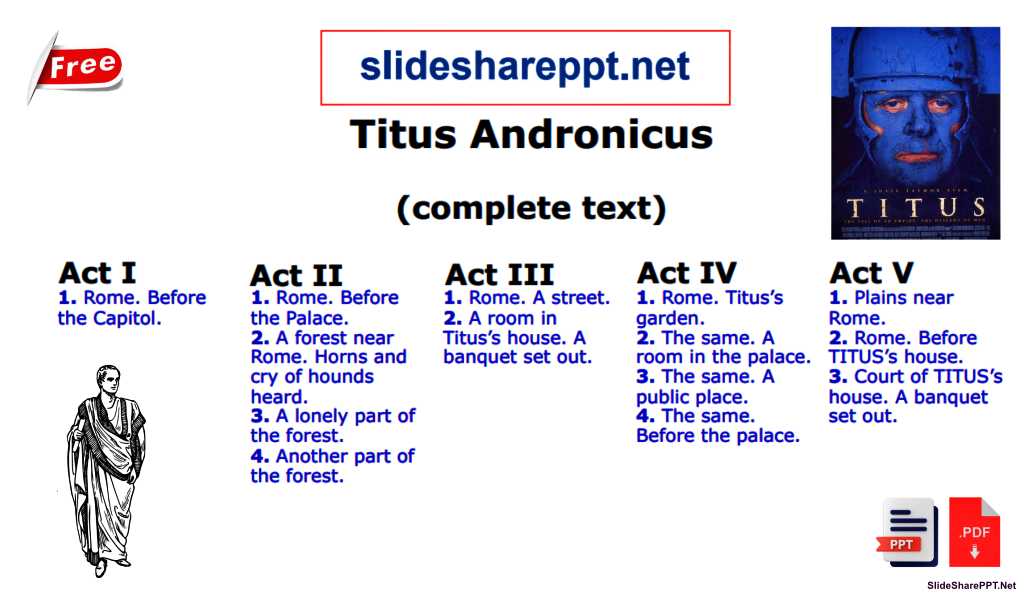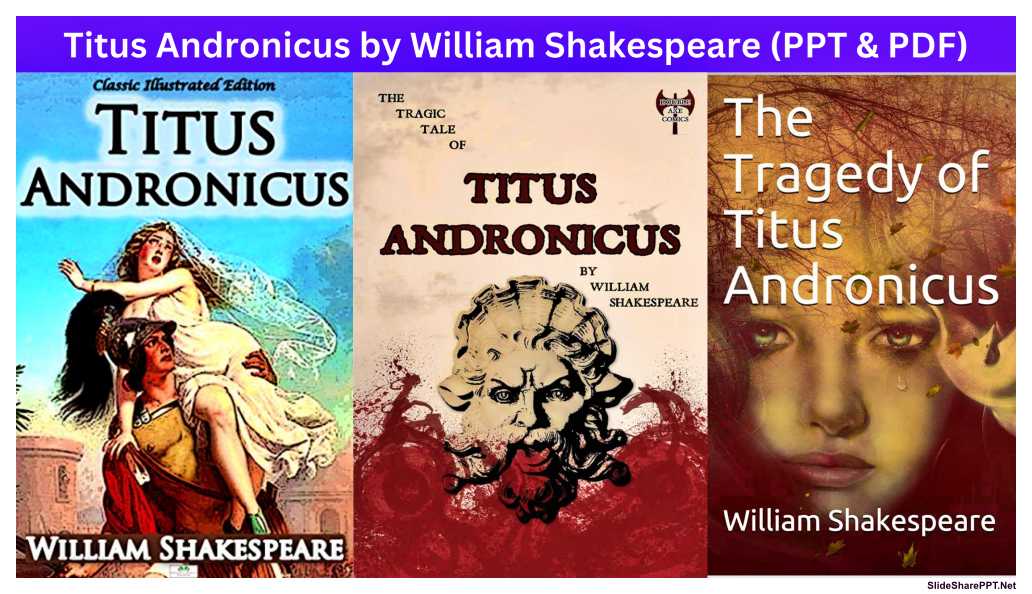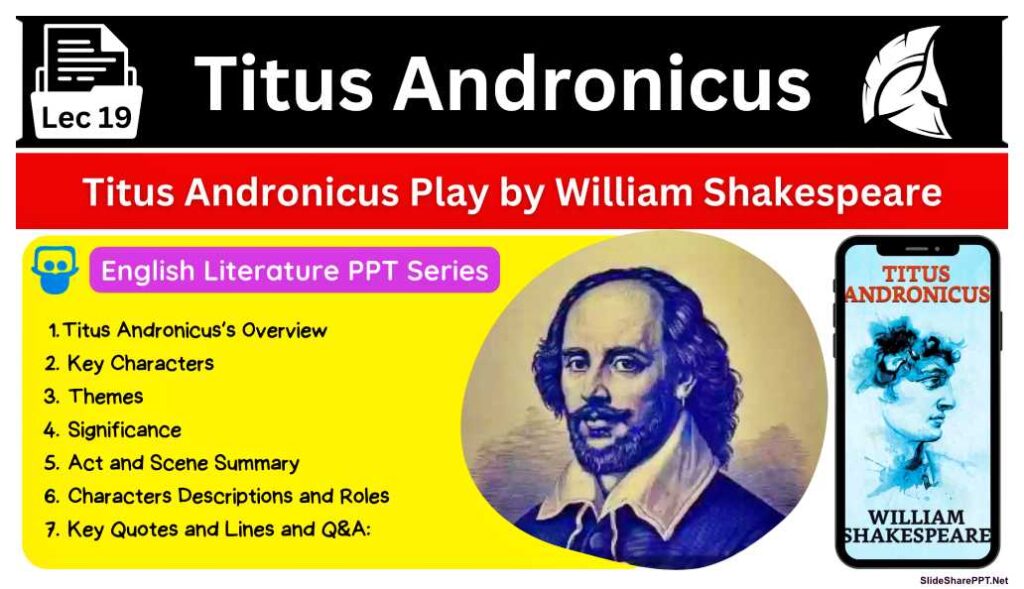Titus Andronicus PPT Slides & PDF Download
Today we have shared the Notes of William Shakespeare’s Famous Play Titus Andronicus PPT Slides & PDF Download, So as we know William Shakespeare’s “Titus Andronicus” is a play that stands out in the bard’s repertoire for its unflinching portrayal of violence, betrayal, and revenge. Written in the early stages of Shakespeare’s career, this tragedy is often overshadowed by his more famous works like “Hamlet” and “Macbeth.” However, “Titus Andronicus” remains a compelling and relevant piece of literature that delves into the darkest aspects of human nature.
Table of Titus Andronicus
Here’s a complete table for “Titus Andronicus”:
| Aspect | Description |
|---|---|
| Title | Titus Andronicus |
| Playwright | William Shakespeare |
| Genre | Tragedy |
| Date of Composition | Estimated to be between 1588 and 1593 |
| Setting | Ancient Rome |
| Main Characters | Titus Andronicus, Tamora, Aaron, Lavinia, Saturninus, Bassianus, Marcus Andronicus, Lucius |
| Plot Overview | The play follows the Roman general Titus Andronicus as he returns from a victorious campaign against the Goths. However, his triumph soon turns to tragedy as he becomes embroiled in a cycle of revenge and violence with the Queen of the Goths, Tamora, and her lover, Aaron. |
| Key Themes | Revenge, violence, justice, power, betrayal, madness |
| Significance | “Titus Andronicus” is one of Shakespeare’s earliest tragedies and is known for its graphic violence and brutality. While not as celebrated as some of Shakespeare’s other works, it remains an important example of Elizabethan revenge tragedy and continues to be studied and performed. |
| Notable Lines | – “Vengeance is in my heart, death in my hand, / Blood and revenge are hammering in my head.” (Act 2, Scene 3) – “Farewell, kind lord; fight valiantly today. / And yet I do thee wrong to mind thee of it, / For thou art framed of the firm truth of valor.” (Act 1, Scene 1) – “O, let me teach you how to knit again / This scattered corn into one mutual sheaf, / These broken limbs again into one body.” (Act 3, Scene 1) |
| Adaptations | Various stage productions, film adaptations, and television adaptations have been made over the years. Notable adaptations include the film “Titus” directed by Julie Taymor (1999) and various stage productions around the world. |
This table provides a comprehensive overview of various aspects of “Titus Andronicus,” including its background, plot, characters, themes, significance, notable lines, and adaptations.
Titus Andronicus PPT Slides
(Lecture 19)
Important:-
- If you are viewing this PPT on your phone, please make it full screen and then view it. (Press: 3 dots in PPT, then Full Screen)
- If you have a problem while clicking on next, (Just tap) on the slide instead of clicking Next Botton.
- FOR A BETTER VIEW PRESS Ctrl + Shift + F ON A PC OR LAPTOP.
- Whatever is written in the PPT is different and whatever is written below is different.

Note: The complete Text PDF Link is at the end of the PowerPoint slides (go to the last PPT Slide)
Tragedy Unveiled: A Complete Summary of “Titus Andronicus”
“Titus Andronicus” is a harrowing tragedy written by William Shakespeare, believed to be one of his earliest works. Set in ancient Rome, the play delves into themes of revenge, betrayal, and the consequences of unchecked violence. Through its depiction of the titular character’s descent into madness and the cycle of retribution that ensues, “Titus Andronicus” explores the darkest corners of the human psyche and the tragic consequences of moral decay.
Plot Overview: The play begins with the triumphant return of the Roman general Titus Andronicus from war, accompanied by prisoners, including Tamora, Queen of the Goths, and her sons. In gratitude for his military successes, Titus sacrifices Tamora’s eldest son, igniting a cycle of revenge and violence. Tamora, now Empress of Rome, conspires with her lover Aaron to seek vengeance against Titus for the death of her son, manipulating events to wreak havoc on Titus and his family.
- As the plot unfolds, Titus’s daughter Lavinia is betrothed to Saturninus, the newly crowned Emperor of Rome, against her will. Jealousy and resentment among Titus’s family members lead to betrayals and power struggles, culminating in the brutal rape and mutilation of Lavinia by Tamora’s sons, Chiron and Demetrius. Overwhelmed by grief and rage, Titus descends into madness, seeking vengeance against Tamora and Saturninus while becoming increasingly detached from reality.
- The play reaches its climax as Titus enacts a gruesome revenge against Tamora and her sons, serving their remains in a pie to Saturninus. In the chaos that ensues, Titus is killed by Saturninus, who is in turn slain by Titus’s surviving son, Lucius. Lucius emerges victorious, avenging his family’s deaths and assuming power in Rome, bringing a semblance of closure to the bloodshed and chaos.
Themes: “Titus Andronicus” explores a multitude of themes, including:
- Revenge and Retribution: The play delves into the destructive nature of revenge, as characters seek vengeance for perceived wrongs, perpetuating a cycle of violence.
- Power and Ambition: Ambition and the pursuit of power drive characters to commit heinous acts, leading to their downfall and the destruction of their families.
- Tragedy and Suffering: The play is marked by themes of tragedy and suffering, as characters endure unimaginable horrors and grapple with profound grief.
- Gender and Power Dynamics: Gender roles and power dynamics are examined, particularly in the brutalization of Lavinia, highlighting the vulnerability of women in a patriarchal society.
- Madness and Sanity: Madness and sanity are recurring motifs, as characters descend into madness in response to the traumas they experience, blurring the lines between reality and delusion.
- Justice and Moral Decay: Questions of justice and moral decay are raised, as characters grapple with the erosion of moral order in society and the consequences of unchecked ambition and vengeance.
Conclusion: “Titus Andronicus” stands as a testament to Shakespeare’s exploration of the darkest aspects of the human condition. Through its depiction of violence, betrayal, and tragedy, the play offers profound insights into the nature of revenge and the consequences of moral decay. Despite its sensationalism and controversy, “Titus Andronicus” remains a compelling and thought-provoking work that continues to captivate audiences with its exploration of the depths of human depravity.
Key Characters
Here’s a complete table highlighting the key characters in “Titus Andronicus”:
| Character | Description |
|---|---|
| Titus Andronicus | A Roman general who returns home victorious from war but becomes embroiled in a cycle of revenge and violence after sacrificing Tamora’s son. |
| Tamora | The Queen of the Goths, later Empress of Rome, who seeks revenge against Titus for the death of her son, aligning herself with Aaron and plotting his downfall. |
| Aaron | A Moorish character, lover of Tamora, and a cunning villain who orchestrates much of the treachery and violence in the play. |
| Lavinia | Titus’s daughter, who suffers horrific mutilation and rape at the hands of Tamora’s sons, Chiron and Demetrius, becoming a symbol of the play’s themes of suffering and tragedy. |
| Saturninus | The newly crowned Emperor of Rome, who becomes entangled in the web of revenge and betrayal orchestrated by Tamora and Aaron. |
| Marcus Andronicus | Titus’s brother, who serves as a voice of reason and compassion amidst the chaos and violence of the play. |
| Lucius | Titus’s eldest son, who emerges as a heroic figure and avenges his family’s deaths, ultimately restoring order to Rome. |
These characters play pivotal roles in the unfolding tragedy of “Titus Andronicus,” each contributing to the themes of revenge, betrayal, and the consequences of unchecked ambition.
Themes
Here’s a complete table outlining the themes present in “Titus Andronicus”:
| Theme | Description |
|---|---|
| Revenge and Retribution | Revenge is a central theme in “Titus Andronicus,” driving much of the plot as characters seek vengeance for perceived wrongs. Titus’s sacrifice of Tamora’s son sets off a cycle of violence, with characters committing gruesome acts of retribution in response to past grievances. |
| Power and Ambition | Ambition and the pursuit of power play a significant role in the play, as characters vie for dominance and control in Rome. Tamora’s ambition drives her quest for revenge against Titus, while Saturninus’s lust for power leads to his downfall as he becomes entangled in Tamora’s schemes. |
| Tragedy and Suffering | “Titus Andronicus” is marked by themes of tragedy and suffering, with characters experiencing unimaginable horrors and enduring profound grief. The brutal mutilation of Lavinia, Titus’s descent into madness, and the deaths of numerous characters underscore the tragic nature of the play. |
| Honor and Duty | Honor and duty are recurring motifs in “Titus Andronicus,” with characters grappling with questions of loyalty and moral obligation. Titus’s rigid adherence to Roman values and sense of duty ultimately leads to his downfall, as he sacrifices his family and personal happiness in service to his country. |
| Gender and Power Dynamics | Gender and power dynamics are explored in the play, particularly in the portrayal of Tamora’s empowerment and subsequent manipulation by Aaron. The brutalization of Lavinia highlights the vulnerability of women in a patriarchal society and the consequences of unchecked male aggression. |
| Madness and Sanity | Madness and sanity are themes that pervade “Titus Andronicus,” with characters descending into madness in response to the traumas they experience. Titus’s descent into madness serves as a reflection of the chaos and brutality of the world around him, blurring the lines between reality and delusion. |
| Justice and Moral Decay | Questions of justice and moral decay are raised throughout the play, as characters grapple with the concepts of right and wrong in a world consumed by violence and revenge. The breakdown of moral order in Rome reflects the broader themes of societal corruption and the erosion of traditional values. |
These themes collectively contribute to the rich tapestry of “Titus Andronicus,” exploring the darker aspects of human nature and society while showcasing Shakespeare’s exploration of complex moral dilemmas and psychological depths.
Significance
Here’s a complete table highlighting the significance of “Titus Andronicus”:
| Aspect | Significance |
|---|---|
| Genre | “Titus Andronicus” is significant as one of Shakespeare’s earliest tragedies and one of the most violent and gruesome plays in his canon. It serves as a precursor to his later tragedies, showcasing themes of revenge, madness, and moral decay. |
| Exploration of Violence | The play is significant for its exploration of extreme violence and brutality, pushing the boundaries of theatrical representation and challenging audiences with its graphic depictions of murder, mutilation, and rape. |
| Influence on Later Works | “Titus Andronicus” has had a lasting impact on literature and drama, influencing later works of tragedy and revenge, including Jacobean revenge tragedies and contemporary adaptations. |
| Psychological Depth | Despite its sensationalism, “Titus Andronicus” offers insights into the psychological depths of its characters, particularly Titus, whose descent into madness reflects the trauma and chaos of the world around him. |
| Treatment of Gender | The play is significant for its treatment of gender, with Lavinia’s brutalization highlighting the vulnerability of women in a patriarchal society and sparking discussions about the representation of gender-based violence in literature. |
| Examination of Moral Decay | “Titus Andronicus” serves as a cautionary tale about the consequences of moral decay and the cycle of violence perpetuated by revenge. It explores the erosion of moral order in society and the destructive effects of unchecked ambition and vengeance. |
| Reception and Critical Controversy | The play has generated significant critical controversy and debate, with scholars and audiences alike grappling with its themes, its portrayal of violence, and its place within Shakespeare’s body of work. |
This table provides a comprehensive overview of the significance of “Titus Andronicus,” highlighting its impact on literature, its exploration of violence and moral decay, and its enduring influence on later works.
Act and Scene Summary
Here’s a complete table summarizing the acts and scenes in “Titus Andronicus”:
| Act | Scene | Summary |
|---|---|---|
| 1 | 1 | The play begins with the triumphant return of the Roman general Titus Andronicus from war, accompanied by prisoners, including Tamora, Queen of the Goths, and her sons. |
| 2 | Titus sacrifices Tamora’s eldest son as a tribute to the gods, igniting a cycle of revenge and violence. | |
| 3 | Saturninus, newly crowned Emperor of Rome, chooses Titus’s daughter Lavinia as his bride, sparking jealousy and resentment among Titus’s family members. | |
| 2 | 1 | Tamora, now Empress of Rome, conspires with her lover Aaron to seek revenge against Titus for the death of her son. |
| 2 | Lavinia is betrothed to Saturninus against her will, and Titus’s sons Bassianus and Saturninus engage in a power struggle over her, resulting in Bassianus’s death. | |
| 3 | Lavinia is brutally raped and mutilated by Tamora’s sons, Chiron and Demetrius, at the instigation of Aaron. | |
| 3 | 1 | Titus descends into madness, seeking vengeance against Tamora and Saturninus, while Lucius, Titus’s son, is banished from Rome for attempting to avenge his sister’s honor. |
| 2 | Tamora, disguised as Revenge, manipulates Titus into framing his remaining son, Lucius, for the murder of Bassianus, leading to Lucius’s imprisonment and Titus’s further descent into madness. | |
| 3 | Aaron confesses his crimes and reveals the truth about Tamora’s deception, leading to a final confrontation between Titus and Tamora’s faction. | |
| 4 | 1 | Titus enacts a gruesome revenge against Tamora and her sons, killing them and serving their remains in a pie to Saturninus. |
| 2 | In the chaos that ensues, Titus is killed by Saturninus, who is in turn slain by Lucius. | |
| 5 | 1 | Lucius emerges victorious, avenging his family’s deaths and assuming power in Rome. |
| 2 | The play ends with Lucius declaring a period of mourning for the tragic events that have transpired, bringing a semblance of closure to the bloodshed and chaos. |
This summary provides a condensed overview of the key events in each act and scene of “Titus Andronicus,” capturing the escalating cycle of revenge and violence that ultimately leads to the downfall of the Andronicus family.
Characters Descriptions and Roles
Here’s a table summarizing the characters’ descriptions and roles in “Titus Andronicus”:
| Character | Description | Role |
|---|---|---|
| Titus Andronicus | A Roman general who returns home victorious from war but becomes embroiled in a cycle of revenge and violence after sacrificing Tamora’s son. | Titus serves as the tragic protagonist of the play, grappling with grief, madness, and a thirst for revenge as he becomes ensnared in a web of betrayal and treachery. |
| Tamora | The Queen of the Goths, later Empress of Rome, who seeks revenge against Titus for the death of her son, aligning herself with Aaron and plotting his downfall. | Tamora is a cunning and vengeful antagonist, driving much of the plot’s violence and manipulation as she conspires to wreak havoc on Titus and his family. |
| Aaron | A Moorish character, lover of Tamora, and a cunning villain who orchestrates much of the treachery and violence in the play. | Aaron serves as Tamora’s co-conspirator, using his cunning and ruthlessness to carry out acts of betrayal and manipulation while reveling in his role as a remorseless villain. |
| Lavinia | Titus’s daughter, who suffers horrific mutilation and rape at the hands of Tamora’s sons, Chiron and Demetrius, becoming a symbol of the play’s themes of suffering and tragedy. | Lavinia represents innocence and victimhood, enduring unspeakable horrors that drive her father to seek vengeance and serving as a poignant reminder of the consequences of unchecked violence. |
| Saturninus | The newly crowned Emperor of Rome, who becomes entangled in the web of revenge and betrayal orchestrated by Tamora. | Saturninus’s lust for power and susceptibility to manipulation make him a pawn in Tamora’s schemes, leading to his downfall as he becomes consumed by jealousy and rage. |
| Marcus Andronicus | Titus’s brother, who serves as a voice of reason and compassion amidst the chaos and violence of the play. | Marcus provides moral guidance and support to Titus and his family, attempting to temper their impulses and prevent further bloodshed in the face of escalating conflict. |
| Lucius | Titus’s eldest son, who emerges as a heroic figure and avenges his family’s deaths, ultimately restoring order to Rome. | Lucius embodies nobility and honor, leading a rebellion against the corrupt rulers of Rome and avenging his family’s deaths, signaling a return to justice and stability after the chaos of the play’s events. |
These characters play crucial roles in the unfolding tragedy of “Titus Andronicus,” each contributing to the themes of revenge, betrayal, and the consequences of unchecked ambition.
Key Quotes and Lines
Here’s a table featuring key quotes and lines from “Titus Andronicus”:
| Character | Quote |
|---|---|
| Titus Andronicus | “Vengeance is in my heart, death in my hand, Blood and revenge are hammering in my head.” |
| Tamora | “Hear me, grave fathers! noble tribunes, stay! For pity of mine age, whose youth was spent In dangerous wars, whilst you securely slept; For all my blood in Rome’s great quarrel shed; For all the frosty nights that I have watched; And for these bitter tears, which now you see Filling the aged wrinkles in my cheeks.” |
| Aaron | “Villain, I have done thy mother.” |
| Lavinia | “O, why should nature build so foul a den, Unless the gods delight in tragedies?” |
| Saturninus | “Worse than Tantalus’ is, to die hungry; Am I in earth, in heaven, or in hell? Sleeping or waking, mad or well-advised? Known unto these, and to myself disguised! I’ll say as they say, and persever so, And in this mist at all adventures go.” |
| Marcus Andronicus | “Oh, let me teach you how to knit again This scattered corn into one mutual sheaf, These broken limbs again into one body; Lest Rome herself be bane unto herself, And she whom mighty kingdoms curtsy to, Like a forlorn and desperate castaway, Do shameful execution on herself.” |
| Lucius | “So, so; now sit: and look you eat no more Than will preserve just so much strength in us As will revenge these bitter woes of ours. Marcus, unknit that sorrow-wreathen knot: Thy niece and I, poor creatures, want our hands, And cannot passionate our tenfold grief With folded arms.” |
These quotes encapsulate the emotions, conflicts, and themes present in “Titus Andronicus,” showcasing the play’s intensity and dramatic power.
Q&A:
1. Who is the main protagonist of “Titus Andronicus”?
- The main protagonist is Titus Andronicus, a Roman general returning to Rome after a victorious war against the Goths.
2. What event sets off the cycle of revenge in the play?
- Titus sacrifices the eldest son of Tamora, Queen of the Goths, in vengeance for the lives lost in the war, setting off a chain reaction of revenge and violence.
3. Who are the primary antagonists in the play?
- Tamora, Queen of the Goths, and her lover Aaron, a Moorish villain, are the primary antagonists who conspire to manipulate events and seek revenge against Titus Andronicus and his family.
4. What themes are explored in “Titus Andronicus”?
- Themes such as revenge, power and ambition, honor and loyalty, violence and brutality, betrayal, madness and sanity, gender and power dynamics, and justice and retribution are explored throughout the play.
5. How does the play portray the consequences of unchecked ambition and power?
- Characters like Saturninus and Tamora are consumed by their hunger for power, leading them to commit heinous acts without remorse, ultimately resulting in their downfall and the destruction of those around them.
6. What role does revenge play in the storyline?
- Revenge is a central theme that drives the plot forward. Characters seek vengeance for perceived wrongs, leading to a cycle of violence and tragic consequences.
7. How does “Titus Andronicus” reflect Elizabethan views on gender and society?
- The play reflects patriarchal views of the time, showcasing gender dynamics and power struggles, particularly in the treatment of female characters and their limited agency within a male-dominated society.
8. What is the significance of the character Aaron in the play?
- Aaron serves as a malicious and unrepentant villain whose actions contribute significantly to the escalating violence and tragedy in the play, showcasing the depths of human cruelty and amorality.
9. How does the play depict the themes of honor and loyalty amidst betrayal?
- Titus Andronicus values honor and loyalty to his family and country, leading him to make extreme sacrifices. However, betrayal from trusted individuals tests these values and results in tragic consequences.
10. What is the overall impact and legacy of “Titus Andronicus”?
- Despite initial mixed reception due to its extreme violence, “Titus Andronicus” has gained appreciation for its exploration of complex themes and characters. Its enduring legacy is seen in adaptations across various media and its continued relevance in exploring human nature and morality.

MCQ:
1. Who is the main protagonist of “Titus Andronicus”?
A) Tamora
B) Aaron
C) Titus Andronicus
D) Saturninus
Answer: C) Titus Andronicus
2. What event sparks the cycle of revenge in the play?
A) Titus’s marriage to Tamora
B) Titus’s sacrifice of Tamora’s eldest son
C) Tamora’s betrayal of Titus
D) Saturninus’s ascension to the throne
Answer: B) Titus’s sacrifice of Tamora’s eldest son
3. Who are the primary antagonists in “Titus Andronicus”?
A) Titus and his sons
B) Aaron and Tamora
C) Saturninus and his advisors
D) Lavinia and Marcus
Answer: B) Aaron and Tamora
4. What themes are explored in “Titus Andronicus”?
A) Revenge, power, and betrayal
B) Love, forgiveness, and redemption
C) Comedy, wit, and romance
D) Nature, beauty, and art
Answer: A) Revenge, power, and betrayal
5. What role does Aaron play in the play’s events?
A) He is Titus’s loyal friend
B) He is the Emperor of Rome
C) He is a malicious villain who manipulates events
D) He is Titus’s eldest son
Answer: C) He is a malicious villain who manipulates events
6. How does “Titus Andronicus” reflect societal views on gender?
A) It challenges traditional gender roles
B) It reinforces patriarchal views
C) It portrays women as powerful leaders
D) It ignores gender dynamics
Answer: B) It reinforces patriarchal views
7. What is the consequence of unchecked ambition in the play?
A) Characters achieve their goals without consequences
B) Characters face betrayal and loss
C) Characters find happiness and contentment
D) Characters embrace forgiveness and redemption
Answer: B) Characters face betrayal and loss
8. What is the overall legacy of “Titus Andronicus”?
A) It is largely forgotten in literary history
B) It is praised for its light-hearted comedy
C) It has influenced later works and adaptations
D) It is known for its happy ending
Answer: C) It has influenced later works and adaptations
9. How does the play depict themes of honor and loyalty?
A) Characters betray each other for personal gain
B) Characters prioritize honor and loyalty despite challenges
C) Characters avoid conflict at all costs
D) Characters are indifferent to moral values
Answer: B) Characters prioritize honor and loyalty despite challenges
10. What is the central conflict in “Titus Andronicus”?
A) A war between Rome and the Goths
B) Titus’s quest for revenge against Tamora
C) Tamora’s rise to power as Empress of Rome
D) Saturninus’s struggle for political control
Answer: B) Titus’s quest for revenge against Tamora
Read the Previous Post: Romeo and Juliet PPT Slides & PDF Download



